Metabolic fuel use
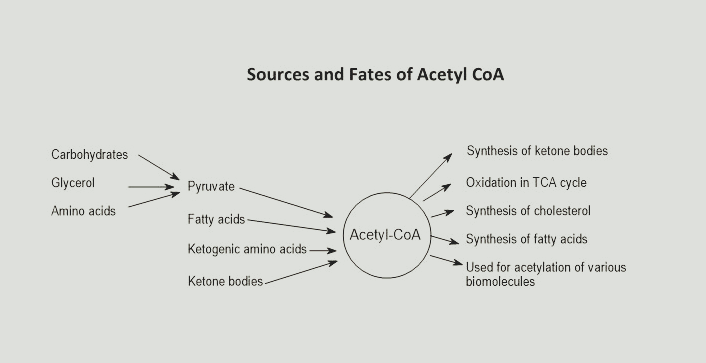
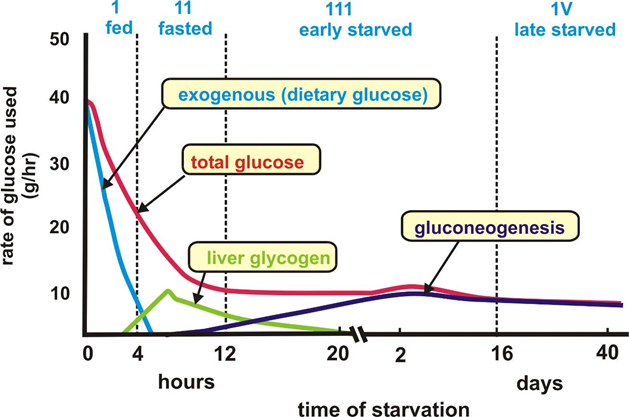
 2. Free fatty acids -> three fatty acids
2. Free fatty acids -> three fatty acids
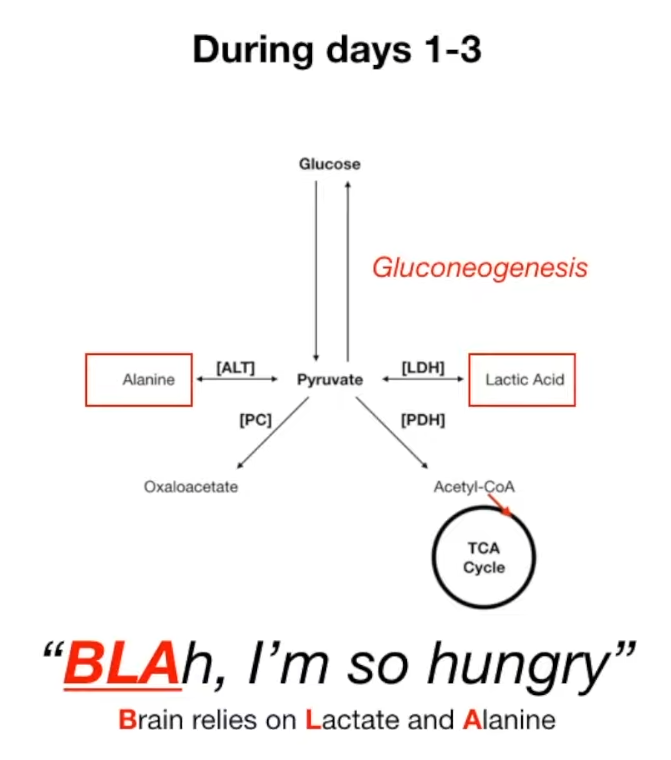
Hormone-sensitive lipase is activated in response to stress hormones (eg, catecholamines, glucagon, ACTH), whereas it is inhibited by the release of insulin.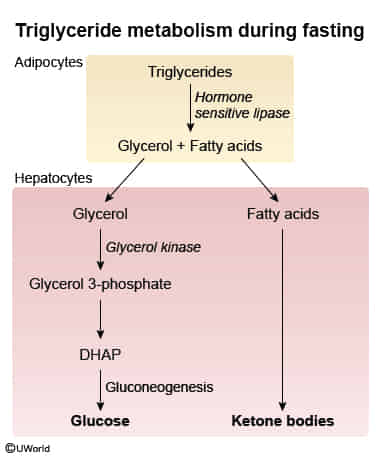
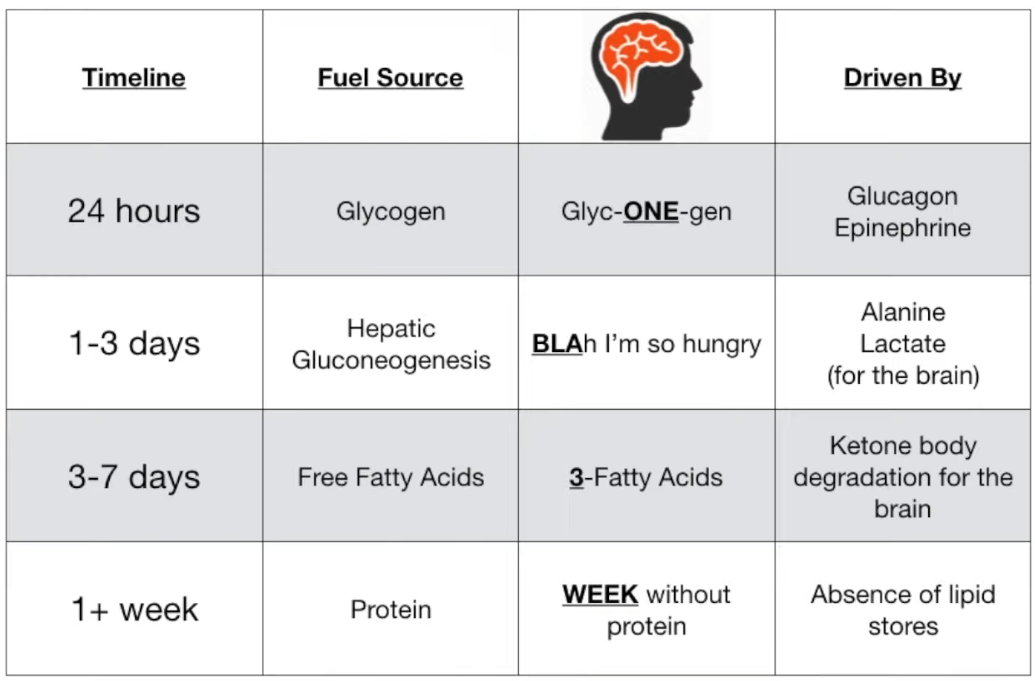
When lack of glucose, the body need new ways to generate acetyl-CoA, which then can be used in TCA cycle
- Fatty acid oxidation
- ketone body metabolism: Ketone bodies are synthesized in liver, then transported in blood to other organs for ketogenolysis, to acetyl-CoA
Regulation by fructose-2,6-bisphosphate
Main idea: Insulin & glucagon control PFK-2 & FBPase-2 → control amount of F-2,6-BP → direction towards gluconeogenesis or glycosis.
Fructose bisphosphatase-2 (FBPase-2) and phosphofructokinase-2 (PFK-2) are the same bifunctional enzyme whose function is reversed by phosphorylation by protein kinase A.

- Fasting state: ↑ glucagon → ↑ cAMP → ↑ protein kinase A → ↑ FBPase-2, ↓ PFK-2, less glycolysis, more gluconeogenesis.
- Fed state: ↑ insulin → ↓ cAMP → ↓ protein kinase A → ↓ FBPase-2, ↑ PFK-2, more glycolysis, less gluconeogenesis.
FaBian the Peasant (FBP) has to work hard when starving.
Prince FrederricK (PFK) works only when fed.
Enzymes Increased in Fed State (High Insulin:Glucagon Ratio)
The fed state focuses on using and storing incoming fuel (anabolism). Insulin is the dominant hormone.
-
Glycolysis & Glucose Uptake (Energy Production & Storage Precursors):
- Glucokinase (Liver) / Hexokinase (Most Tissues): Traps glucose in the cell by phosphorylating it to glucose-6-phosphate. Glucokinase in the liver is induced by insulin.
- Phosphofructokinase-1 (PFK-1): The rate-limiting enzyme of glycolysis. Activated by fructose-2,6-bisphosphate (F-2,6-BP).
- Phosphofructokinase-2 (PFK-2): Activated by insulin. PFK-2 produces F-2,6-BP, which strongly activates PFK-1, pushing glycolysis forward.
- Pyruvate Kinase: Catalyzes the final, irreversible step of glycolysis.
-
Glycogen Synthesis (Glucose Storage):
- Glycogen Synthase: The rate-limiting enzyme for glycogenesis. Activated by insulin-mediated dephosphorylation.
-
Fatty Acid & Triglyceride Synthesis (Fat Storage):
- Acetyl-CoA Carboxylase (ACC): The rate-limiting enzyme for fatty acid synthesis. Activated by insulin and citrate.
- Fatty Acid Synthase: Synthesizes fatty acids from acetyl-CoA and malonyl-CoA.
- Lipoprotein Lipase (LPL): Found on endothelial cells; breaks down triglycerides from chylomicrons and VLDL for uptake into adipose tissue and muscle. Activated by insulin.
Enzymes Increased in Fasting State (Low Insulin:Glucagon Ratio)
The fasting state focuses on mobilizing stored fuel to maintain blood glucose for the brain and RBCs (catabolism). Glucagon and epinephrine are the dominant hormones.
-
Glycogenolysis (Glucose Release from Storage):
- Glycogen Phosphorylase: The rate-limiting enzyme of glycogenolysis. Activated by glucagon and epinephrine via a cAMP-mediated cascade.
-
Gluconeogenesis (New Glucose Synthesis):
- Pyruvate Carboxylase: Converts pyruvate to oxaloacetate. Activated by acetyl-CoA.
- Phosphoenolpyruvate Carboxykinase (PEPCK): Converts oxaloacetate to PEP. Upregulated by glucagon and cortisol.
- Fructose-1,6-bisphosphatase: Bypasses PFK-1 in glycolysis. Inhibited by F-2,6-BP.
- Glucose-6-phosphatase: Found only in the liver; dephosphorylates G6P to release free glucose into the blood.
-
Lipolysis & Fatty Acid Oxidation (Fat Breakdown for Energy):
- Hormone-Sensitive Lipase (HSL): Breaks down stored triglycerides in adipocytes into free fatty acids and glycerol. Activated by glucagon and epinephrine; inhibited by insulin.
- Carnitine Palmitoyltransferase I (CPT-I): Rate-limiting enzyme for β-oxidation; transports fatty acids into the mitochondria.
-
Ketogenesis (Alternate Fuel Production):
- HMG-CoA Synthase: Rate-limiting enzyme for ketone body synthesis in the liver mitochondria.
- HMG-CoA Lyase: Produces acetoacetate from HMG-CoA.